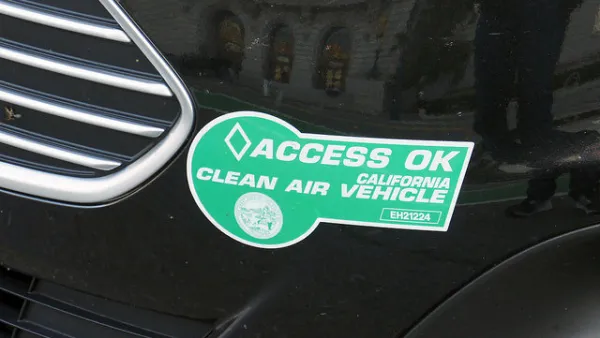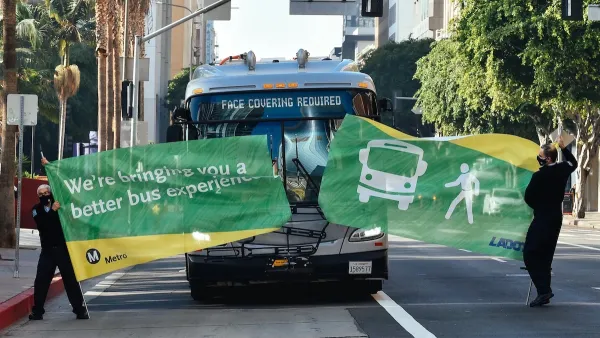The 110 High Occupancy Toll Lanes, conversions of carpool lanes, appear to be a victim of their own success, writes LA Times transportation reporter Laura J. Nelson. An economist would say the solution is to raise the maximum per-mile toll. Or is it?
"So many drivers now steer into the Harbor Freeway's northbound toll lanes to escape morning traffic jams that the paid route is slowing down too," writes Los Angeles Times transportation reporter Laura Nelson. "Over the course of a year, even as the per-mile toll crept toward the maximum, traffic in the paid lanes increased by almost 20% and speeds began to slow."
Metro's algorithm modifies the per-mile toll as frequently as every five minutes, based on how many cars are using the lanes. Tolls range from 25 cents to $1.40 a mile, for a maximum one-way price of $15.40 along the 11-mile route.
Would raising the $1.40 maximum per-mile toll alleviate the problem? Nelson makes a strong case that the toll schedule is irrelevant during peak hours.
But drivers who don't pay tolls from their own wallets have made it more difficult for Metro to influence demand through prices, said Kathleen McCune, Metro's congestion reduction director. Contractors, lawyers and consultants who bill clients for the toll will pay the price, no matter how high. "It could go up to $2,000 a mile and it wouldn't matter to them," she said.
The experts at Brookings take a different perspective.
"The fact that the speeds are getting low suggests prices aren't high enough," said Clifford Winston, a Brookings Institute economist who focuses on transportation policy. "There's no such thing as a price ceiling. If tolls went up to $10 per mile, I'm sure it would have an effect."
This correspondent sides with Brookings. While the toll lanes opened in November 2012, the toll schedule was determined three years earlier, as our July 2009 post indicates. How many transit systems haven't raised their fares six years?
Rather than just looking at the problem of oversubscription of the toll lanes, it's important to put the current situation into perspective. Two years ago Nelson wrote of just the opposite problem (posted here): undersubscription.
Hat tip to Len Conly of Sierra Club Chapter Transportation Chairs listserv.
FULL STORY: MTA's toll-lane project may be a victim of its own success

National Parks Layoffs Will Cause Communities to Lose Billions
Thousands of essential park workers were laid off this week, just before the busy spring break season.

Retro-silient?: America’s First “Eco-burb,” The Woodlands Turns 50
A master-planned community north of Houston offers lessons on green infrastructure and resilient design, but falls short of its founder’s lofty affordability and walkability goals.

Delivering for America Plan Will Downgrade Mail Service in at Least 49.5 Percent of Zip Codes
Republican and Democrat lawmakers criticize the plan for its disproportionate negative impact on rural communities.

Test News Post 1
This is a summary

Test News Headline 46
Test for the image on the front page.

Balancing Bombs and Butterflies: How the National Guard Protects a Rare Species
The National Guard at Fort Indiantown Gap uses GIS technology and land management strategies to balance military training with conservation efforts, ensuring the survival of the rare eastern regal fritillary butterfly.
Urban Design for Planners 1: Software Tools
This six-course series explores essential urban design concepts using open source software and equips planners with the tools they need to participate fully in the urban design process.
Planning for Universal Design
Learn the tools for implementing Universal Design in planning regulations.
EMC Planning Group, Inc.
Planetizen
Planetizen
Mpact (formerly Rail~Volution)
Great Falls Development Authority, Inc.
HUDs Office of Policy Development and Research
NYU Wagner Graduate School of Public Service




























